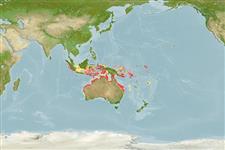Environment: milieu / climate zone / depth range / distribution range
Ecología
marino asociado a arrecife; rango de profundidad ? - 30 m (Ref. 37748). Tropical
Distribución
Países | Áreas FAO | Ecosistemas | Ocurrencias, apariciones | Point map | Introducciones | Faunafri
Indo-Pacific: endemic to Western Australia and Queensland.
Tamaño / Peso / Age
Maturity: Lm ? range ? - ? cm
Max length : 8.0 cm TL macho / no sexado; (Ref. 37748)
Short description
Morfología | Morfometría
Espinas dorsales (total): 3; Radios blandos dorsales (total): 22-24; Espinas anales 3; Radios blandos anales: 12 - 14; Vértebra: 28 - 29. Head and body with small, bright blue spots. Uninterrupted lower lip at symphysis. Dorsal and anal rays mostly unbranched and segmented. Upper part of caudal fin with 4-5 procurrent rays and 9 principal rays; the lower part with 4-5 procurrent and 8 principal rays. Disjunct lateral line; anterodorsal series of 33-43 (usually 36-40) tubed scales extending from gill opening. Usually 19 or 20 circumpeduncular scales (Ref. 37748).
Occurs inshore near reefs (Ref. 7300) and weed bed areas; usually in relatively silty waters at depths up to 30 m. A secretive species usually found at highly eroded limestone reef and rocks (Ref. 37748).
Life cycle and mating behavior
Madurez | Reproducción | Puesta | Huevos | Fecundidad | Larva
Gill, A.C., 1999. Pseudochromidae. Dottybacks (eelblennies). p. 2557-2577. In Carpenter, K. E. and V. E. Niem. 1999. Species identification guide for fisheries purposes. The living marine resources of the western central Pacific. Bony fishes part 2 (Mugilidae to Carangidae). FAO, Rome. : iii-v; 2069-2790. (Ref. 37748)
IUCN Red List Status (Ref. 130435)
Threat to humans
Harmless
Human uses
Acuario: Potencial
Más información
PaísesÁreas FAOEcosistemasOcurrencias, aparicionesIntroduccionesStocksEcologíaDietacomponentes alimenticiosconsumo de alimentoRación
Nombres comunesSinónimosMetabolismoDespredadoresEcotoxicologíaReproducciónMadurezPuestaAgregación para la puestaFecundidadHuevosEgg development
Age/SizeCrecimientoLength-weightLength-lengthLength-frequenciesMorfometríaMorfologíaLarvaDinámica larvariaReclutamientoAbundanciaBRUVS
ReferenciasAcuiculturaPerfil de acuiculturaRazasGenéticaElectrophoresesheritabilidadEnfermedadesProcesamientoNutrientsMass conversion
ColaboradoresImágenesStamps, Coins Misc.SonidosCiguateraVelocidadTipo de nataciónSuperficie branquialOtolitosCerebrosVisión
Herramientas
Special reports
Download XML
Fuentes de Internet
Estimates based on models
Preferred temperature (Ref.
123201): 24.6 - 29.3, mean 28.2 °C (based on 1035 cells).
Phylogenetic diversity index (Ref.
82804): PD
50 = 1.0000 [Uniqueness, from 0.5 = low to 2.0 = high].
Bayesian length-weight: a=0.01122 (0.00514 - 0.02450), b=3.04 (2.87 - 3.21), in cm total length, based on all LWR estimates for this body shape (Ref.
93245).
Nivel trófico (Ref.
69278): 3.5 ±0.6 se; based on size and trophs of closest relatives
Fishing Vulnerability (Ref.
59153): Low vulnerability (10 of 100).
Nutrients (Ref.
124155): Calcium = 132 [78, 234] mg/100g; Iron = 0.876 [0.544, 1.390] mg/100g; Protein = 18.9 [17.9, 19.9] %; Omega3 = 0.176 [0.106, 0.283] g/100g; Selenium = 22.2 [11.9, 40.6] μg/100g; VitaminA = 155 [55, 431] μg/100g; Zinc = 1.95 [1.35, 2.72] mg/100g (wet weight);
